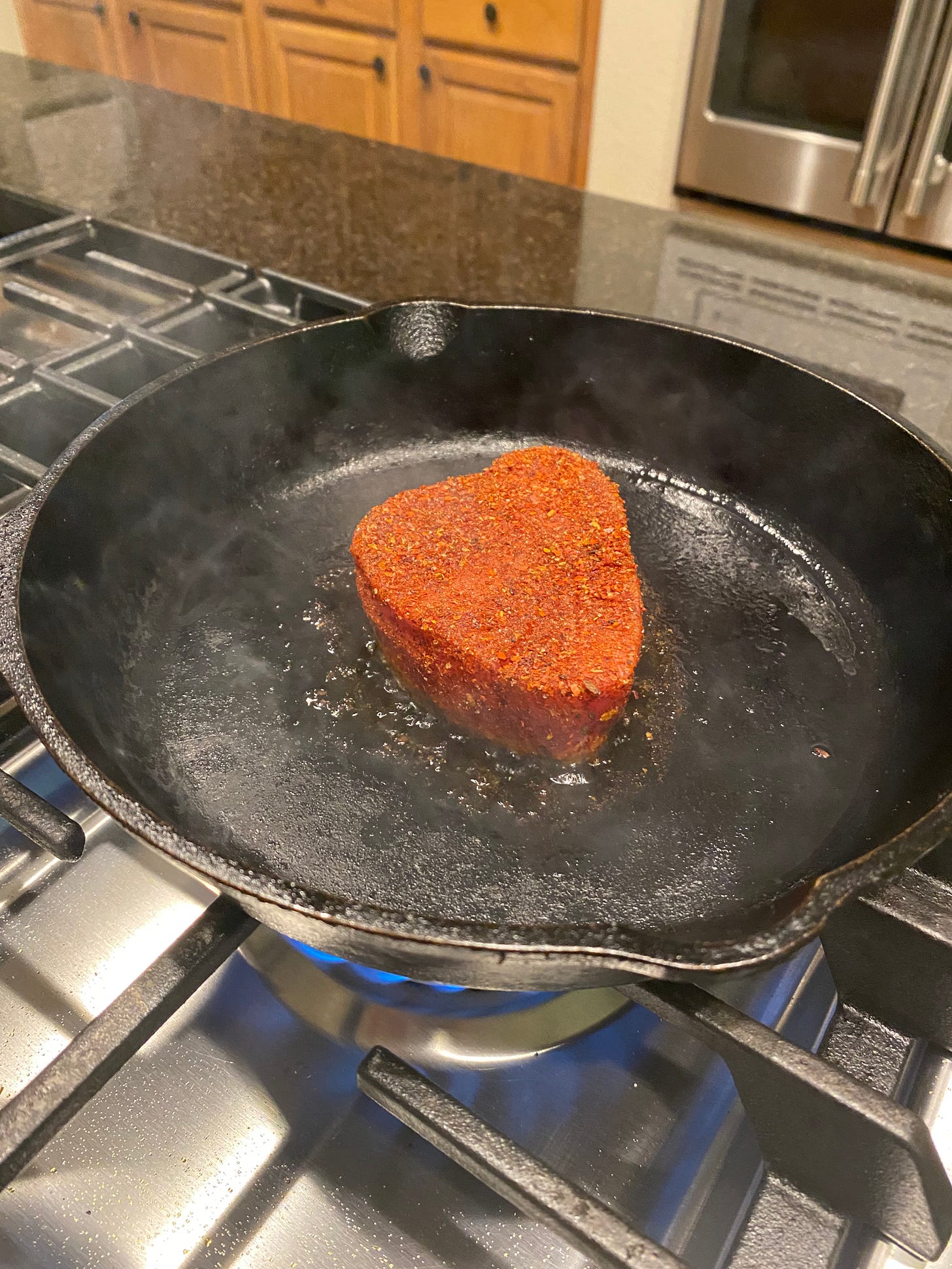Welcome Frens! 🏝
It’s been a busy week in The Jungle with all you avatars… the amount of quality content being shared across the board is staggering. The Subscriber count here keeps going up and I’m very grateful to see demand for my expertise! WAGMIT!
Today we are going to walk through a quick, easy and delicious preparation that even Level 1-NGMI cooks can crank out. Also have an exciting announcement for you all at the end, but first….
Let’s talk “Chicken of the Sea”…. Aka Tuna!
I’ve posted a couple of pictures that capture my Tuna steak preparations on Twitter… with the growing number of “recipe” requests it only made sense to break this down today and give you some tips to put this in your weekly rotation.
Why Tuna?
A few nutritional considerations:
Tuna is a good source of
-Protein
-Omega-3 Fats (brain health and anti-inflammatory)
-Potassium (lower blood pressure)
-B-12 & Iron (improved blood circulation)
-Vitamin D (bone strength/maintenance)
Just to name a few!
On top of that, sourced correctly, Tuna steaks are delicious and quick to get on the table.
So let’s begin:
First things first: Tuna
Find a good source for properly stored Ahi Tuna. “Ahi” is the Hawaiian term that encompasses two species: YellowFin and BigEye.
Notice I said properly stored.
There is a big myth in sourcing seafood that “fresh is always best”. This is just not true. What’s more important is how the fish was transported to the supplier, and storage conditions used.
Autist Note: some of the most revered sushi counters in the world use an aging process… meaning older can be better, in the right hands! 😉
Back to selecting our Ahi. You want to find fresh Ahi that looks bright, vibrant and is not dull, muddy or “mushy” looking; the latter is a dead giveaway of improper storage conditions. A local fish monger or certain grocery stores can be good spots to find. If you are having trouble finding good quality, there is another answer.
IQF Ahi Tuna Steaks. This would be a superior option than a “fresh” tuna steak that was improperly stored. The Tuna tends be processed quickly and portioned before being “individually quick frozen” (IQF). You can find these at wholesale clubs and are remarkably consistent in quality, for our uses here. Simply place in the fridge the night before and they should slowly thaw before dinner time.
Preparation:
You Will Need
-Cast Iron or Stainless Steel sauté pan
-Avocado Oil (or other high heat tolerant cooking oil)
-(2) Ahi Tuna Steaks (approx 6oz ea, 1.5-2 inches thickness)
-2 TB korean chili flake
-1 TB sea salt
-1 tsp Chinese 5 spice powder (I make my own blend)
Pre-Heat sauté pan over high heat (If using cast iron allow 10 mins to fully heat the pan through; stainless AllClad pan would take 4-5mins).
Whisk/stir the chili, salt and 5-spice together in a small bowl; set aside.
While your pan is heating, thoroughly dry your tuna steaks, removing any exterior moisture. (If using IQF you will have slightly more liquid to purge.)
Take 2 tsp of the oil and brush/rub tuna steaks entirely. Then take your spice mixture and apply to top, bottom, and sides of the tuna steaks to cover evenly.
Into your hot pan, add 1 TB of oil and tilt pan to evenly distribute the oil.
The oil should be smoking, carefully place the tuna steaks in the pan, and give a mild press with your hand to ensure full contact with the pan. (The first sear side, will be your presentation side)
Allow to cook for 30-60 seconds. You want to get a nice color on the steaks without scorching them. (The Maillard and caramelization you are building here with the sear is 90% of the flavor.)
Flip your tuna steaks and allow to cook on the second side for another 30-45 seconds. (You don’t need to go as long on this side since it’s not our presentation side and we don’t want to overcook the Tuna).
Remove your steaks to a platter, keeping your presentation side up. And they are ready for eating. Serve with a steak knife to get a nice cut that won’t rip apart the flesh.
And there you have it. Tuna steaks in 12-15mins.
In this case I prepared Carolina Gold rice grits, to sit beneath the finished Tuna Steak and a simple arugula salad with wasabi vinaigrette.
Some notes: you can change the seasonings. Examples would be Japanese Togarashi spice, Spanish smoked paprika, or a Provencal spice to do a play on Tuna Nicoise. Also, while your cast iron is heating you can prepare a side starch or vegetables.
And now for an exciting announcement!
Over the past few weeks Octopod has been getting more and more requests for recipes, specific techniques and even Zoom cooking class inquiries.
In light of this, a Paid Substack will be launching in the next 7-10 days.
What can you expect?
The free weekly Substack will continue to cover Macro-Culinary topics, lifestyle, and beverage.
The Paid Substack will drop weekly ($5/month) and will have specific recipes, photos and more detailed instructions for improving your cooking and meal enjoyment. This will also give a forum for questions and clarifications in the Substack comments. (Think of Today as a test example!)
This is Step 1 in building out resources to help everyone cook better, eat better as we make our way to the Island 🏝. More to follow!
Until next time Frens! 🥂










Pulled an NGMI move and grilled one without consulting the recipe (forgot to look). Overcooked it sadly.
Will try again later this week and report back.
Great post as usual! Always did it with salt & pepper only, never thought about seasoning with other spices (although I have all the mentioned ones). Presentation-wise, love the bed of rice too (I usually put it on the side, this stops now!).